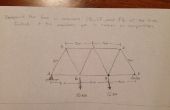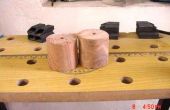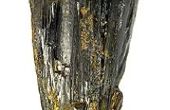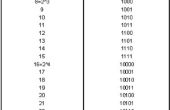Paso 2: Traducir la fórmula para JavaScript
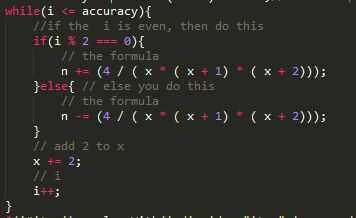
3 + 4 / ( 2 * 3 * 4) + 4 / (4 * 5 * 6) + .....
Los números en el denominador se aumenta en 2 y hemos utilizado x + 1 es 3 x + 2 es 4. Así obtenemos 3 + 4/(2*(2+1)*(2+2)) +...
Se utiliza x en lugar de 2 porque hay que añadir 2 a todos ellos cada vez. Y ahora mira.
Sólo usar si quiere.
<! Html DOCTYPE > if(parseInt(Value) < 2) {}
< html >
< head >
< script src = "http://ajax.googleapis.com/ajax/libs/jquery/1.10.2/jquery.min.js" >< / script >
< script src="latextit.js" >< / script >
< script tipo = "texto/javascript" >
$({document).ready(function()}
$(' {#button').click(function()}
var valor = $('input[name=accuracyPercent]').val();
ALERT ("debe ser más de" + parseInt(value) + "");
} else if(parseInt(value) > 80) {}
ALERT ("debe ser menos" + parseInt(value) + "");
} else {}
primer inferior
var x = 2;
la variable que recoge la estimación de pi
var n = 3;
término inicial
var i = 2;
exactitud de var = parseInt(value) * bucle de //while 2000;
mientras (i < = exactitud) {}
Si i es par, entonces ello
Si (i % 2 == 0) {}
la fórmula de
n += (4 / ( x * ( x + 1) * ( x + 2)));
} else {/ / otro haces esto
la fórmula de
n -= (4 / ( x * ( x + 1) * ( x + 2)));
}
Añadir 2 a x
x += 2;
me
i ++;
}
$('#item').replaceWith ('< div id = "artículo" >' + n + ' </div >');
}
});
$(' {#button').mouseover(function()}
$(this) .css ('color', '#fff');
});
$(' {#button').mouseleave(function()}
$(this) .css ('color', ' #000')
});
});
< /script >
< estilo tipo = "text/css" >
{cuerpo}
fondo: - webkit-lineal-gradient(-45deg, #0ff, blue); / * Para Safari * /
fondo: -o-lineal-gradient(-45deg, #0ff, blue); / * Para Opera 11.1 a 12.0 * /
fondo: - moz-linear-gradient(-45deg, #0ff, blue); / * Para Firefox 3.6 a 15 * /
fondo: lineal-gradient(-45deg, #0ff, blue); / * Estándar * /
}
{} de forma
Mostrar: inline-block;
color de fondo: azul;
}
#button {}
Mostrar: inline-block;
altura: 20px;
anchura: 70px;
color de fondo: #cc0000;
font-family: arial;
font-weight: bold;
color: #000;
frontera-radius: 5px;
texto-alinee: Centro;
margen-top: 2px;
}
#item {}
texto-alinee: Centro;
tamaño: 40px;
color: #000;
}
.List {}
font-size: 20px;
}
< / estilo >
< /HEAD >
< cuerpo >
< nombre del formulario = "accuracyPercent" >
< entrada tipo = "text" name = "accuracyPercent" / >
< / form >
< div id = "botones" > Haz! < / div >
< clase p = "la lista" >
Vamos a encontrar el valor de < span lang = "látex" >$ \pi$ < /span > al punto de exactitud. (Recuerde, su valor debe ser mayor que 2, menos de 1000 y un número entero):
< /p >
< div id = "artículo" >
3,14159 26535 89793 23846
< / div >
< /body >
< / html >

